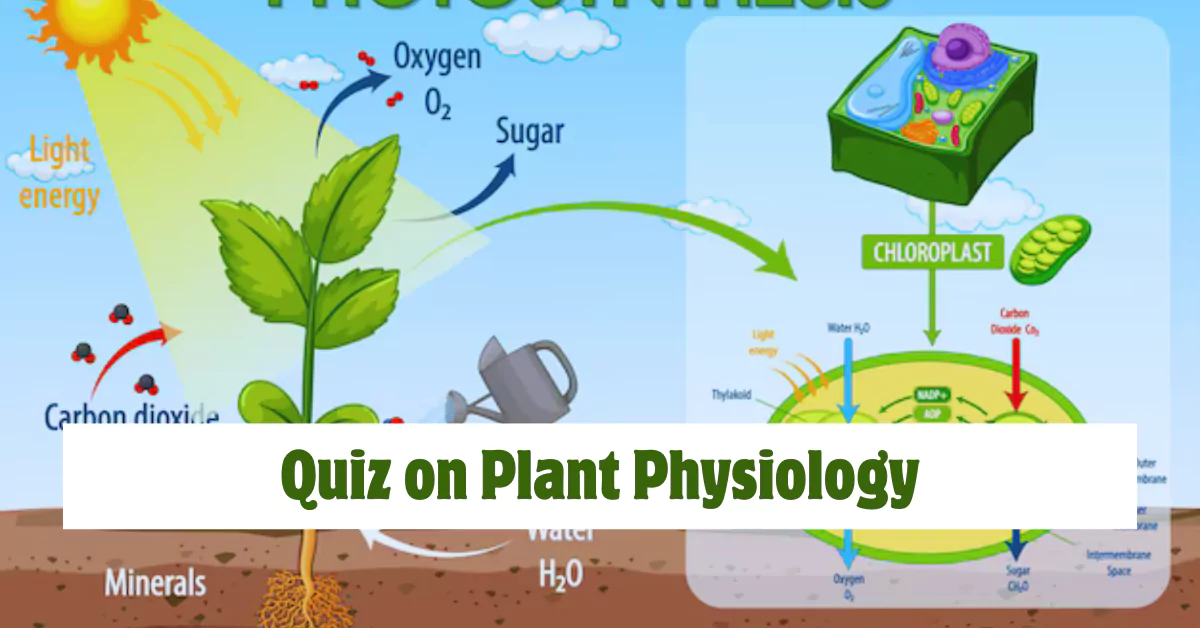NEET UG 2025: These 25 carefully designed objective questions on Plant Physiology cover key NEET UG topics, including Photosynthesis, Respiration, Transport Mechanisms, Plant Growth and Hormones, Mineral Nutrition, and Plant Movement. They are structured to assess students’ comprehensive understanding, critical thinking, and ability to apply fundamental concepts, ensuring thorough preparation for the NEET UG 2025 examination.
1. The oxygen evolved during photosynthesis comes from:
(a) CO₂
(b) H₂O
(c) Glucose
(d) Chlorophyll
2. The C₄ pathway minimizes photorespiration by concentrating CO₂ in the form of:
(a) PGA
(b) RuBP
(c) OAA
(d) Malate
| NEET UG Counselling Guide 2025 | |
|---|---|
| State-wise MBBS/BDS Counselling Guide eBook 2025 | 📥 Download |
| MCC NEET UG Counselling Guide eBook 2025 | 📥 Download |
| AACCC AYUSH NEET Counselling Guide eBook 2025 | 📥 Download |
3. In CAM plants, CO₂ fixation mainly occurs:
(a) During day
(b) During night
(c) Both day and night
(d) Early morning only
4. The primary acceptor of CO₂ in the Calvin cycle is:
(a) RuBP
(b) PGA
(c) Glucose
(d) NADPH
5. The enzyme Rubisco catalyzes:
(a) ATP formation
(b) Reduction of NADP⁺
(c) Fixation of CO₂
(d) Photolysis of water
6. The respiratory quotient (RQ) of carbohydrate metabolism is usually:
(a) 0.7
(b) 0.8
(c) 1.0
(d) 1.5
7. Glycolysis occurs in the:
(a) Mitochondria
(b) Chloroplast
(c) Cytoplasm
(d) Nucleus
8. Anaerobic respiration in plants produces:
(a) Ethanol and CO₂
(b) Pyruvate only
(c) Glucose and ATP
(d) Lactic acid only
9. Krebs cycle occurs in:
(a) Cytosol
(b) Mitochondrial matrix
(c) Chloroplast stroma
(d) Endoplasmic reticulum
10. The net ATP gain in glycolysis from one glucose molecule is:
(a) 2 ATP
(b) 4 ATP
(c) 6 ATP
(d) 36 ATP
11. Water movement in plants occurs mainly through:
(a) Phloem
(b) Xylem
(c) Cortex
(d) Epidermis
12. Root pressure results from:
(a) Active mineral absorption
(b) Transpiration
(c) Osmosis alone
(d) Photosynthesis
13. The cohesion-tension theory explains:
(a) Sugar transport
(b) Water ascent
(c) Mineral uptake
(d) Gas exchange
14. Phloem transport is:
(a) Unidirectional and passive
(b) Bidirectional and active
(c) Bidirectional and passive
(d) Unidirectional and active
15. Guttation is primarily due to:
(a) Transpiration pull
(b) Root pressure
(c) Photosynthesis
(d) Capillarity
16. The growth hormone primarily responsible for cell elongation is:
(a) Cytokinin
(b) Auxin
(c) Gibberellin
(d) ABA
17. Abscisic acid (ABA) promotes:
(a) Leaf expansion
(b) Seed dormancy
(c) Fruit ripening
(d) Stem elongation
18. Phototropic movement in plants is regulated by:
(a) Cytokinins
(b) Auxins
(c) Ethylene
(d) Gibberellins
19. Cytokinins mainly stimulate:
(a) Cell elongation
(b) Cell division
(c) Fruit ripening
(d) Leaf fall
20. Ethylene promotes:
(a) Stem elongation
(b) Seed germination
(c) Fruit ripening
(d) Root growth
21. Chlorosis in plants is commonly due to a deficiency of:
(a) Iron
(b) Magnesium
(c) Potassium
(d) Calcium
22. Nitrogen fixation in legumes occurs in the presence of:
(a) Nitrosomonas
(b) Rhizobium
(c) Azotobacter
(d) Nostoc
23. The element essential for the photolysis of water is:
(a) Magnesium
(b) Manganese
(c) Iron
(d) Copper
24. A short-day plant flowers when:
(a) Day length exceeds a critical duration
(b) Day length is shorter than a critical duration
(c) Night length is shorter
(d) Day and night length are equal
25. Thigmotropism refers to plant response to:
(a) Light
(b) Gravity
(c) Chemicals
(d) Touch
✅ Answer Key:
1.(b), 2.(d), 3.(b), 4.(a), 5.(c), 6.(c), 7.(c), 8.(a), 9.(b), 10.(a), 11.(b), 12.(a), 13.(b), 14.(b), 15.(b), 16.(b), 17.(b), 18.(b), 19.(b), 20.(c), 21.(a), 22.(b), 23.(b), 24.(b), 25.(d)
Share your quiz scores in the comments section, and our experts will review your performance to provide personalized tips to help you improve your NEET score.
These 25 carefully selected objective questions cover essential aspects of Plant Physiology, including Photosynthesis, Respiration, Transport, Plant Hormones, Mineral Nutrition, and Photoperiodism. They effectively test NEET UG aspirants’ understanding and readiness for competitive examination.


